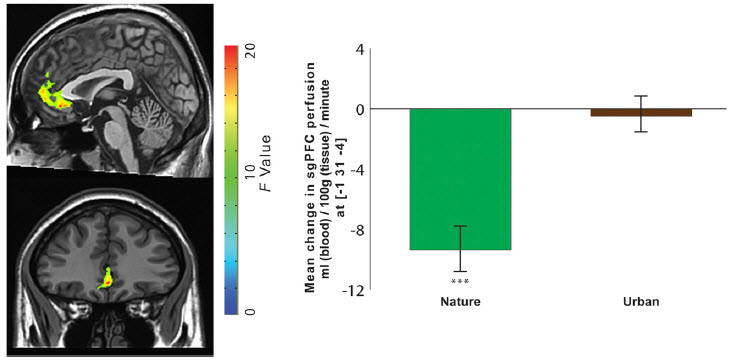Walking in nature lowers risk of depression, scientists find in MRI study
July 1, 2015
A new study has found quantifiable evidence that supports the common-sense idea that walking in nature could lower your risk of depression.
The study, published in Proceedings of the National Academy of Science, found that people who walked for 90 minutes in a natural area, as opposed to participants who walked in a high-traffic urban setting (El Camino Real in Palo Alto, California, a noisy street with three to four lanes in both directions), showed decreased activity in the subgenual prefrontal cortex, a brain region active during rumination — repetitive thought focused on negative emotions.
“These results suggest that accessible natural areas may be vital for mental health in our rapidly urbanizing world,” said co-author Gretchen Daily, the Bing Professor in Environmental Science and a senior fellow at the Stanford Woods Institute for the Environment. “Our findings can help inform the growing movement worldwide to make cities more livable, and to make nature more accessible to all who live in them.”
“This finding is exciting because it demonstrates the impact of nature experience on an aspect of emotion regulation — something that may help explain how nature makes us feel better,” said lead author Gregory Bratman, a graduate student in Stanford’s Emmett Interdisciplinary Program in Environment and Resources, the Stanford Psychophysiology Lab and the Center for Conservation Biology.

The impact of nature experience on self-reported rumination and blood perfusion to the subgenual prefrontal cortex. A time-by-environment interaction in blood perfusion was evident in the subgenual prefrontal cortex. Change in blood perfusion (postwalk minus prewalk) for participants randomly assigned to take a 90-min walk either in a natural setting or in an urban setting. Error bars represent standard error within subjects: P < 0.001. (credit: Gregory N. Bratman et al./PNAS)
“These findings are important because they are consistent with, but do not yet prove, a causal link between increasing urbanization and increased rates of mental illness,” said co-author James Gross, a professor of psychology at Stanford.
Essential for urban planners to incorporate nature
It is essential for urban planners and other policymakers to understand the relationship between exposure to nature and mental health, the study’s authors write. “We want to explore what elements of nature — how much of it and what types of experiences — offer the greatest benefits,” Daily said.
As noted in the paper, “Never before has such a large percentage of humanity been so far removed from nature [1]; more than 50% of people now live in urban areas, and by 2050, this proportion will be 70% [2]. Although urbanization has many benefits, it is also associated with increased levels of mental illness, including anxiety disorders and depression [3-5].”
In a previous study, also led by Bratman, time in nature was found to have a positive effect on mood and aspects of cognitive function, including working memory, as well as a dampening effect on anxiety.
The studies are part of a growing body of research exploring the connection between nature and human well-being. The Natural Capital Project, led by Daily, has been at the forefront of this work. The project focuses on quantifying the value of natural resources to the public and predicting benefits from investments in nature. It is a joint venture of the Stanford Woods Institute for the Environment, The Nature Conservancy, the World Wildlife Fund and the University of Minnesota’s Institute on the Environment.
1. Turner WR, Nakamura T, Dinetti M (2004) Global urbanization and the separation of
humans from nature. Bioscience 54(6):585–590.
2. Dye C (2008) Health and urban living. Science 319(5864):766–769.
3. Lederbogen F, et al. (2011) City living and urban upbringing affect neural social stress
processing in humans. Nature 474(7352):498–501.
4. Peen J, Schoevers RA, Beekman AT, Dekker J (2010) The current status of urban-rural
differences in psychiatric disorders. Acta Psychiatr Scand 121(2):84–93.
5. Wang JL (2004) Rural-urban differences in the prevalence of major depression and
associated impairment. Soc Psychiatry Psychiatr Epidemiol 39(1):19–25.
Abstract of Nature experience reduces rumination and subgenual prefrontal cortex activation.
Urbanization has many benefits, but it also is associated with increased levels of mental illness, including depression. It has been suggested that decreased nature experience may help to explain the link between urbanization and mental illness. This suggestion is supported by a growing body of correlational and experimental evidence, which raises a further question: what mechanism(s) link decreased nature experience to the development of mental illness? One such mechanism might be the impact of nature exposure on rumination, a maladaptive pattern of self-referential thought that is associated with heightened risk for depression and other mental illnesses. We show in healthy participants that a brief nature experience, a 90-min walk in a natural setting, decreases both self-reported rumination and neural activity in the subgenual prefrontal cortex (sgPFC), whereas a 90-min walk in an urban setting has no such effects on self-reported rumination or neural activity. In other studies, the sgPFC has been associated with a self-focused behavioral withdrawal linked to rumination in both depressed and healthy individuals. This study reveals a pathway by which nature experience may improve mental well-being and suggests that accessible natural areas within urban contexts may be a critical resource for mental health in our rapidly urbanizing world.